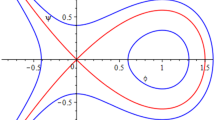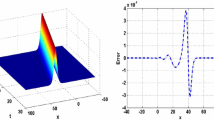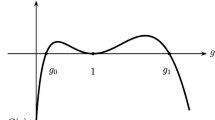Abstract
In this manuscript, based on the geometric singular perturbation theory, several new solitary wave solutions in a perturbed generalized Benjamin–Bona–Mahony (BBM) equation are detected by the explicit calculation of the associated Melnikov integrals. These solitary wave solutions are homoclinic to non-trivial steady states and have not been found before. We also determine the zeroth-order approximations to the speeds of these solitary waves explicitly. In the calculations of the Melnikov integrals, the explicit expressions of the unperturbed homoclinic orbits play an important role.





Similar content being viewed by others
References
Korteweg, D.J., de Vries, G.: On the change of form of long waves advancing in a rectangular channel and on a new type of long stationary waves. Phi. Mag. 39, 422–443 (1895)
Johnson, R.S.: A nonlinear equation incorporating damping and dispersion. J. Fluid Mech. 42, 49–60 (1970)
Liu, Z., Yang, C.: The application of bifurcation method to a higher-order KdV equation. J. Math. Anal. Appl. 275, 1–12 (2002)
Wazwaz, A.: Exact solution with compact and non-compact structures for the one-dimensional generalized Benjamin–Bona–Mahony equation. Commun. Nonlinear Sci. Numer. Simul. 10, 855–867 (2005)
Derks, G., Gils, S.: On the uniqueness of traveling waves in perturbed Korteweg-de Vries equations. Jpn. J. Ind. Appl. Math. 10, 413–430 (1993)
Fenichel, N.: Geometric singular perturbation theory for ordinary differential equations. J. Differ. Equ. 31, 53–98 (1979)
Jones, C.K.R.T.: Geometric singular perturbation theory. In: Johnson, R. (ed.) Dynamical Systems, Lecture Notes in Mathematics, vol. 1609. Springer, New York (1995)
Hek, G.: Geometric singular perturbation theory in biological practice. J. Math. Biol. 60, 347–386 (2010)
Xu, Y., Du, Z., Wei, L.: Geometric singular perturbation method to the existence and asymptotic behavior of traveling waves for a generalized Burgers-KdV equation. Nonlinear Dyn. 83, 65–73 (2016)
Zhuang, K., Du, Z., Lin, X.: Solitary waves solutions of singularly perturbed higher-order KdV equation via geometric singular perturbation method. Nonlinear Dyn. 80, 629–635 (2015)
Shang, X., Du, Z.: Traveling waves in a generalized nonlinear dispersive-dissipative equation. Math. Methods Appl. Sci. 39, 3035–3042 (2016)
Chen, A., Guo, L., Deng, X.: Existence of solitary waves and periodic waves for a perturbed generalized BBM equation. J. Differ. Equ. 261, 5324–5349 (2016)
Chen, A., Guo, L., Huang, W.: Existence of kink waves and periodic waves for a perturbed defocusing mKdV equation. Qual. Theory Dyn. Syst. 17, 495–517 (2018)
Li, J., Zhu, W., Chen, G.: Understanding peakons, periodic peakons and compactons via a shallow water wave equation. Int. J. Bifurc. Chaos Appl. Sci. Eng. 26, 1650207 (2016)
Xia, B., Qiao, Z., Li, J.: An integrable system with peakon, complex peakon, weak kink, and kink-peakon interactional solutions. Commun. Nonlinear Sci. Numer. Simul. 63, 292–306 (2018)
Dumortier, F., Li, C.: Perturbation from an elliptic Hamiltonian of degree four. IV. Figure eight-loop. J. Differ. Equ. 188, 512–554 (2003)
Dumortier, F., Li, C.: Perturbation from an elliptic Hamiltonian of degree four. III. Global centre. J. Differ. Equ. 188, 473–511 (2003)
Dumortier, F., Li, C.: Perturbations from an elliptic Hamiltonian of degree four. I. Saddle loop and two saddle cycle. J. Differ. Equ. 176, 114–157 (2001)
Wiggins, S.: Introduction to Applied Nonlinear Systems and Chaos. Springer, New York (1990)
Wiggins, S.: Global Bifurcations and Chaos. Analytical Methods. Springer, New York (1988)
Author information
Authors and Affiliations
Corresponding author
Ethics declarations
Conflict of interest
The authors declare that they have no conflict of interest.
Additional information
Publisher's Note
Springer Nature remains neutral with regard to jurisdictional claims in published maps and institutional affiliations.
The authors acknowledge the financial support of the Natural Science Foundations of China (No. 11771082).
Appendix
Appendix
1.1 The explicit expressions of homoclinic orbits for the unperturbed system (11)
Here, we only give the detailed derivation of the explicit expression of homoclinic orbit for the unperturbed system (11) when \(C\in (-\frac{4}{27}, 0)\). The other cases are similar and hence are omitted.
The homoclinic orbit in this case is determined by
where \(x=x_{3}\) is solved from \(x^3-x^2-C=0\), and \(x=x_{1}, x=x_{5}\) are determined by \(-\frac{1}{3}x^{3}+\frac{1}{4}x^{4}-Cx=h\) where \(-\frac{4}{27}<C<0\), \(h=u(x_{3})\).
If \(x>x_{3}\), let \(x-x_{3}=\frac{1}{u}>0\), we get
Then, setting \(x_{3}u+1-x_{1}u=v\) gives
Now let \(\sqrt{v}=w\), one obtains
i.e.,
where \(\sigma \) is a constant of integral.
Without loss of generality, let \(X_{5}(x_{5},0)\) be the initial point, that is, \(x(0)=x_{5}\), then
Denote
we obtain
Similarly, if \(x<x_{3}\), we can derive
1.2 The detailed calculations of the Melnikov integrals
Case 1 When \(C=0\).
In this case, the Melnikov integral is
where \(x(\tau )\) is given in (21).
Consider
we thus have
Here, \(x(\tau )=\frac{1}{\frac{3}{4}+\frac{\tau ^{2}}{6}}\), hence we have \(a=3/4\) and \(b=1/6\), and thus,
Case 2 When \(C=-\frac{2}{27}\).
The Melnikov integral is
in which
Denote \(\chi =\frac{\sqrt{6}}{3}\mathrm{sech}(\frac{\sqrt{3}}{3}\tau )\), then
Let
it follows from \(\mathrm{sech} p^{2}=1-\mathrm{tanh}p^{2}\) and \(d\mathrm{tanh}p=\mathrm{sech}p^{2}dp\) that
where \(p=\frac{\sqrt{3}}{3}\tau \), \(\eta =\sqrt{3}(\frac{\sqrt{6}}{3})^{k}\), which is equivalent to
where \(\mu =\mathrm{tanh}p\).
Let
which becomes
where \(\theta =\sin \gamma \). When \(m=0, 1, 2, 3, \cdots \), it can be calculated that
and when \(m=\frac{1}{2},\frac{3}{2},\frac{5}{2},\frac{7}{2}, \cdots \),
Obviously,
thus
and
which finally gives
Case 3 When \(C=-\frac{4}{27}\).
In this case, \(x(\tau )=\frac{2}{3}-\frac{1}{\frac{3}{4}+\frac{\tau ^{2}}{3}}\). Denote \(\chi (\tau )=\frac{1}{\frac{3}{4}+\frac{\tau ^{2}}{3}}\); direct calculation gives the Melnikov integral
By further calculation, we get
Rights and permissions
About this article
Cite this article
Zhu, K., Wu, Y., Yu, Z. et al. New solitary wave solutions in a perturbed generalized BBM equation. Nonlinear Dyn 97, 2413–2423 (2019). https://doi.org/10.1007/s11071-019-05137-9
Received:
Accepted:
Published:
Issue Date:
DOI: https://doi.org/10.1007/s11071-019-05137-9




